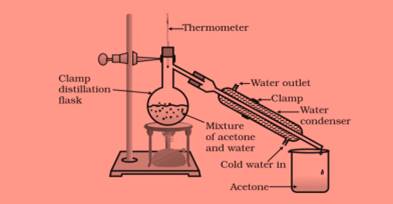Science
(www.olympiadsuccess.com)
Chapter 2: Is Matter Around Us Pure?
Class: IX
Exercise 3
Question 1:
How will you separate a mixture containing kerosene and petrol (difference in their boiling points is more than 25°C), which are miscible with each other?
Answer 1:
Distillation method is used for separating a miscible liquid having difference in their boiling points more than 25°C. Therefore, distillation can be used for separating kerosene and petrol.

In distillation method, the mixture of miscible liquid, kerosene and petrol is taken in a distillation flask. The distillation flask has a thermometer fitted in it. Other than flask, we need a beaker, a water condenser, and a Bunsen burner for conducting this experiment . These apparatus need to arranged as shown in the figure. After that, slowly heat the mixture taken in the flask and watch the thermometer simultaneously. Then the kerosene will vaporize and get condensed in the water condenser. From the condenser outlet we can collect the kerosene, whereas petrol is left behind in the distillation flask.
Question 2:
Name the technique to separate
(i) butter from curd
(ii) salt from sea-water
(iii) camphor from salt.
Answer 2:
(i) centrifugation.
(ii) evaporation.
(iii) sublimation.
Question 3:
What type of mixtures is separated by the technique of crystallization?
Answer 3:
By using crystallization method, we can separate pure solids from impure solutions.
Examples of crystallization, salt is separated from impurities, alum crystals separated from impure samples.
Yearlong program for Olympiads preparation & to build necessary skills for future.
Explore More
Time to mark your calendar with the upcoming Olympiads exam schedule.
Explore More
Take your Olympiad preparation to next-level by taking LIVE Classes.
Explore More
Assess your performance by taking topic-wise and full length mock tests.
Explore More
Online tuitions for international compeitions like SASMO, SEAMO, etc for Grades 1-11.
Explore More